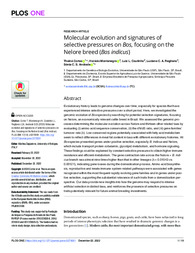Molecular evolution and signatures of selective pressures on Bos, focusing on the Nelore breed (Bos indicus).
Molecular evolution and signatures of selective pressures on Bos, focusing on the Nelore breed (Bos indicus).
Author(s): CORTEZ, T.; MONTENEGRO, H.; COUTINHO, L. L.; REGITANO, L. C. de A.; ANDRADE, S. C. S.
Summary: Evolutionary history leads to genome changes over time, especially for species that have experienced intense selective pressures over a short period. Here, we investigated the genomic evolution of Bos species by searching for potential selection signatures, focusing on Nelore, an economically relevant cattle breed in Brazil. We assessed the genomic processes determining the molecular evolution across Nelore and thirteen other related taxa by evaluating (i) amino acid sequence conservation, (ii) the dN/dS ratio, and (iii) gene families? turnover rate (lambda. Low conserved regions potentially associated with fatty acid metabolism seem to reflect differences in meat fat content in taxa with different evolutionary histories. All Bos species presented genes under positive selection, especially B. indicus and Nelore, which include transport protein cobalamin, glycolipid metabolism, and hormone signaling. These findings could be explained by constant selective pressures to obtain higher immune resistance and efficient metabolism. The gene contraction rate across the Nelore + B. indicus branch was almost nine times higher than that in other lineages (lambda = 0.01043 vs. 0.00121), indicating gene losses during the domestication process. Amino acid biosynthesis, reproductive and innate immune system-related pathways were associated with genes recognized within the most frequent rapidly evolving gene families and in genes under positive selection, supporting the substantial relevance of such traits from a domestication perspective. Our data provide new insights into how the genome may respond to intense artificial selection in distinct taxa, and reinforces the presence of selective pressures on traits potentially relevant for future animal breeding investments.
Publication year: 2022
Types of publication: Journal article
Observation
Some of Embrapa's publications are published as ePub files. To read them, use or download one of the following free software options to your computer or mobile device. Android: Google Play Books; IOS: iBooks; Windows and Linux: Calibre.
Access other publications
Access the Agricultural Research Database (BDPA) to consult Embrapa's full library collection and records.
Visit Embrapa Bookstore to purchase books and other publications sold by Embrapa.

